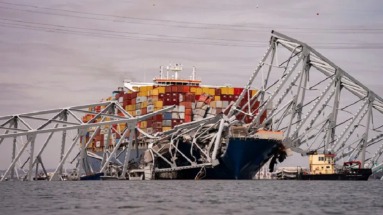
Advertisement
The arrival of the largest crane on the eastern US seaboard in Baltimore marks a pivotal moment in the extensive clean-up efforts following the tragic collapse of the Francis Scott Key Bridge. This monumental crane, known as the Chesapeake 1000, has been deployed as part of a massive salvage operation to address the aftermath of the devastating incident.
As shipments in and out of one of the nation’s busiest ports remain suspended, the wreckage of the collapsed bridge looms over the cargo ship that collided with it, underscoring the magnitude of the task at hand. The search for the bodies of four missing workers has been temporarily halted due to the perilous conditions posed by the wreckage, further emphasizing the challenges faced by rescue and recovery teams.
In response to the catastrophe, the federal government has allocated $60 million in emergency funds to support the ongoing recovery efforts. President Joe Biden has announced plans to visit Baltimore next week to assess the situation firsthand and discuss federal assistance measures.
The Francis Scott Key Bridge collapse has not only dealt a severe blow to the local community but has also disrupted vital economic activities. The Port of Baltimore serves as a cornerstone of Maryland’s economy, facilitating the import and export of goods crucial to US and global trade.
The tragic incident unfolded early on Tuesday as eight construction workers were engaged in repairing potholes on the bridge. The collision with the Dali container ship caused a significant portion of the structure to plunge into the Patapsco River, resulting in multiple casualties and leaving several workers missing.
Efforts to recover and salvage the submerged vehicles and debris have been met with significant challenges, including the sheer volume of steel and concrete encasing the wreckage. The deployment of the Chesapeake 1000 crane, capable of lifting 1,000 tons, represents a critical step in the complex operation to clear the debris and reopen the Port of Baltimore.
However, the recovery process must proceed with caution to prevent further environmental hazards, such as the leakage of hazardous materials stored in the shipping containers aboard the Dali. Authorities are working tirelessly to contain any potential spills and mitigate the environmental impact of the disaster.
As the community grapples with the aftermath of the tragedy, the collective efforts of rescue workers, government agencies, and local residents are focused on restoring normalcy and honoring the memory of the victims. The road to recovery may be long and arduous, but with perseverance and unity, Baltimore will emerge stronger from this challenging ordeal.
